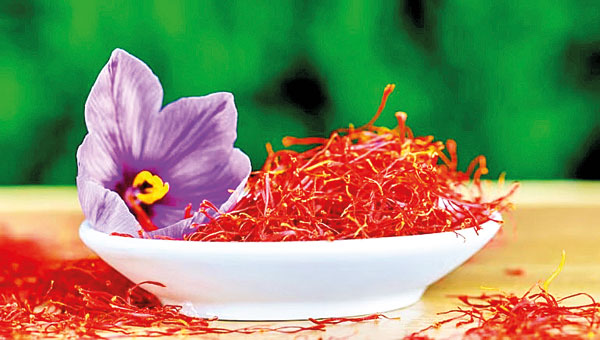Sunday Times 2
Saffron: Unveiling cosmetic secrets of Red Gold
View(s):By Shellon Gunaratna
In the history of the world, few spices have painted as vivid a hue as saffron. It is obtained by carefully drying the stigma (the slender, thread-like parts of a flower) of the Crocus sativus L. flower, a process that underscores its value and rarity. Saffron’s esteemed as the world’s most expensive spice, and dubbed ‘Red Gold’, particularly in Iran. Saffron’s annual global yield is 205 tons, with over 80% originating from Iran. Its distinctive taste, colour, and aroma have not only seasoned cuisines across various cultures but have also found a revered place in ancient medicine and dyes.
To produce just one kilogram of this precious spice, between 150,000 to 200ax,000 flowers are required, alongside roughly 400 hours of laborious work. This intensive manual effort has been unchanged for millennia, it involves the delicate harvesting of flowers, followed by the careful separation of the stigmas. These stigmas are then dried, a critical step that determines the spice’s final quality, flavour, and colouring properties.

Saffron offers multiple skin health benefits. Pic courtesy shutterstock
The main ingredients of saffron are crocin and crocetin which are carotenoids derived from zeaxanthin which gives saffron its yellow colour, picrocrocin which gives saffron its taste, and safranal which gives saffron its distinctive aroma. The quality of saffron depends on the concentration of these three main metabolites providing the unique colour and flavour of stigmas. The chemical composition of saffron samples from many countries indicates that the reported values strongly depend on the methods used for drying, extraction and stigma analysis. The quality of saffron is thus regulated by ISO 3632 standards, which standardises the classification of saffron worldwide.
The beauty industry has witnessed a significant shift towards natural ingredients, with saffron emerging as a key component. This article delves into the scientifically validated advantages of incorporating saffron into your skincare routine. Whitening effect
Melanogenesis is the process where melanocytes produce melanin which makes our skin darker in colour. The starting substance for this process is tyrosine, which is triggered by sunlight exposure or hormonal changes and the enzyme tyrosinase plays a crucial role in accelerating the production of melanin, if tyrosinase were to be inhibited the process of melanin production would decrease thus making our skin lighter in colour.
A recent study highlighted the remarkable skin-lightening benefits of saffron, revealing that a formulation containing a 3% saffron extract can significantly reduce pigmentation in human skin. This depigmentation effect is largely attributed to the potent antioxidant properties of saffron, which are provided by compounds such as monoterpenoids, crocin, quercetin, kaempferol, and other phenolic elements. The actions of these compounds reduce skin melanin by inhibiting the activity of tyrosinase therefore melanin cannot be produced thus making your skin lighter in colour.
Antiaging effect
Saffron’s ability to combat wrinkles stems from its rich antioxidant properties which can neutralise harmful free radicals. Free radicals are unstable molecules produced through various internal and external processes. Internally, they can be generated during normal cellular metabolism when our bodies convert food into energy. Externally, exposure to UV light from the sun, pollution, cigarette smoke, and certain chemicals can cause their production. These free radicals seek stability by stealing electrons from other molecules, causing cellular damage, accelerating ageing, and contributing to wrinkle formation. Saffron’s antioxidants, including kaempferol, crocin, crocetin, and safranal, combat wrinkles by neutralising free radicals, preventing them from stealing electrons from healthy cells and thus halting cellular damage and ageing.
Safranal, in particular also block enzymes like elastase, collagenase, and hyaluronidase that break down vital skin protein and inhibit matrix metalloproteinases (MMPs), which are crucial to skin ageing. Therefore, saffron, with its antioxidants and the specific effects of safranal, offers dual protection against ageing by neutralizing free radicals and inhibiting enzymes that degrade skin proteins.
Sun protection
Research has highlighted saffron’s potential as an effective ultraviolet (UV) absorbing agent and also it possesses a measurable Sun Protection Factor (SPF), underscoring its capability to safeguard the skin against harmful UV rays. Comparative studies indicate that lotion containing saffron could outperform homosalate (an organic UV filter) in effectiveness. This evidence points to saffron’s promising role as a sunscreen, offering a natural and potentially more effective solution for shielding the skin from UV damage.
Saffron, revered as ‘Red Gold,’ transcends its culinary uses to unveil remarkable cosmetic benefits. From lightening skin and reducing ageing signs to protecting against UV rays, its diverse properties showcase nature’s prowess in skincare. The ancient use cases of saffron are being reinforced by modern science, highlighting the cosmetic benefits of saffron. By integrating saffron-infused products like oils, masks, gels, serums, and creams into your daily routine, you can unlock the myriad advantages this spice offers.
(The writer holds a BSc in Cosmetic Science from the University of Sunderland, United Kingdom. He can be contacted at Shellogunaratna@gmail.com)

